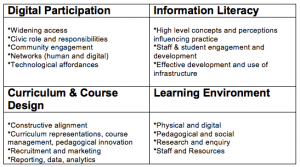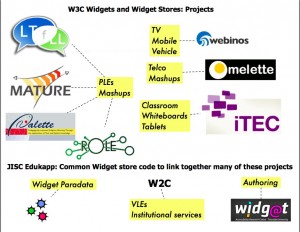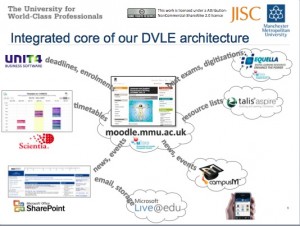One of the most enjoyable aspects of the programme support aspect of my job is that I get to find out about a lot of really innovative work taking place across a diverse range of UK universities. On the flip side of this, I do sometimes yearn to be part of the development of projects instead of always just being on the outside looking in once plans have been made and funding secured. I also often wonder if anything I write about in my blog does actually make any difference or is useful to the wider to community.
So I was delighted yesterday to spend the afternoon at Edinburgh Napier University at an internal seminar exploring their digital future and technological ambitions. I was even more delighted a couple of weeks ago when Keith Smyth contacted me about attending the event, and said that the series of blog posts I wrote with my Strathclyde colleague Bill Johnston on the Digital University, had been really useful and timely for Napier in terms of them starting to think about how to develop their approach to a digital strategy.
Yesterday’s seminar was an opportunity for staff from across the institution to come together and share their experiences and views on what their real needs and aspirations are in terms of the future (digital) shape of the university. Napier are already involved in a number of innovative projects internally, and are committed to open practice, particularly in regards to their work in learning technology. For example their 3E Framework for effective use of technology in teaching and learning, is available via a CC licence and is being used/adapted by over 20 institutions worldwide who have all agreed to share their adaptations. A great example of how open practice can not only improve internal working practices but also have an impact in terms of helping community knowledge grow in an open, shareable way too. The framework is also linked to a resource bank,with examples of the framework in action, which again is openly available.
Like many institutions, podcasting is a growing trend and their College2Uni podcasts which were originally designed to help student transition from college to university are now being used for wider community driven information sharing initiatives. Plans for an open access journal are also well underway.
But what/where next? What should the long, medium and short term goals for the institution be? Participants were asked to consider “what will today’s ten year old’s expect when they come to University in 2020?” Delegates were divided into six groups set short (i.e. can be in place in a year) as well as longer term aspirational goals. The six themes were:
*Developing digital literacies
*Digital equivalence
*Digitally enhanced education
*Digital communication and outreach
*Digital scholarship
*Digital infrastructure and integration
Again, another wee ego boost, was seeing how the matrix Bill and I have developed, provided a framework for the discussions and planning of the workshop.

MacNeill/Johnston conceptual matrix (revised, October 2012)
It was also a good opportunity for me to highlight work from a number of JISC programmes including Developing Digital Literacies, Assessment and Feedback, and Curriculum Design and Delivery and the growing number of resources from all these programmes which are available from the Design Studio.
There was a genuine enthusiasm from all the delegates a number of suggestions for easily achievable short term goals including single sign on for all uni accounts, more co-ordinated and easily accessible communication channels (for staff and students), experimenting with lay out of lecture spaces, developing a more coherent strategy for mobile devices. Longer term goals were generally centred on ubiquitous access to information, continuous development of staff and student skills including supporting open practices, ways to differentiate Napier and how to take advantage of affordances of the all pervasive MOOCs and indeed the changing landscape of HE. Content maybe more plentiful in 2020 but not everyone has the skills to take an MIT/Stanford/Everyotherbignameuniversity open course without support. There are a lot of skills which we know employers are looking for which aren’t supported through these large scale distance models of education. The need for new spaces (both digital and physical) for experimentation and play for both staff and students was highlighted as a key way to support innovation. You can get a flavour of the discussion by searching the #digiednap archive.
The next steps for Napier, are the forming of working group to take forward the most popular ideas from the session. There was a bit of the old “dotmocracy” with delegates voting for their preferred short terms ideas:
@edinburghnapier staff viewing and voting on their favourite digital ideas to take forward in next year #digiednap twitter.com/smythkrs/statu…
— Keith Smyth (@smythkrs) December 10, 2012
and work on more strategic developments over the coming year. I am really looking forward to working with colleagues in Napier as a critical friend to these developments, and being part of a project from the outset and seeing first hand how it develops.

